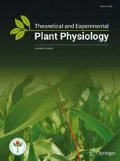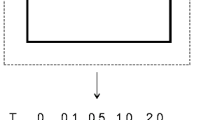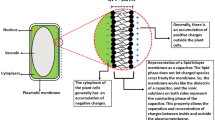Abstract
How does the new affect the old but mutable living systems? This is the question that electromagnetism stress has been provoking. There are many evidence that non-ionic radiation can affect animal cells since their plasticity is limited when compared to plants. However, the way plants perceive and process this stressor is still poorly understood. So here are some intriguing facts that lead us to reflect on how and why electromagnetism can become a very common stressor for years to come for plant species.
Similar content being viewed by others
References
Balmori A (2009) Electromagnetic pollution from phone masts. Effects on wildlife. Pathophysiology 16:191–199
Balmori A (2015) Anthropogenic radiofrequency electromagnetic fields as an emerging threat to wildlife orientation. Sci Total Environ 518:58–60
Betts RA, Alfieri L, Knight JR, Bradshaw C, Caesar J, Feyen L, Friedlingstein P, Gohar L, Koutroulis A, Lewis K, Morfopoulos C, Papadimitrou L, Richardson KJ, Tsanis L, Wyser K (2018) Changes in climate extremes, fresh water availability and vulnerability to food insecurity projected at global warming with a higher-resolution global climate model. Philos Trans R Soc A. https://doi.org/10.1098/rsta.2016.0452
Bulak P, Lata L, Plak A, Wiącek D, Strobel W, Walkiewicz A, Pietruszewski S, Bieganowski A (2018) Electromagnetic field pretreatment of Sinapis alba seeds improved cadmium phytoextraction. Inter J Phytoremediat 20:338–342
Bystrzejewska-Piotrowska G, Golimowski J, Urban PL (2009) Nanoparticles: their potential toxicity, waste and environmental management. Waste Manage 29:2587–2595
Dannehl D (2018) Effects of electricity on plant responses. Sci Hortic 234:382–392
Gupta A, Singh R, Lehana P (2013) Effect of microwaves treated soil on growth of mustard plants. IJSCE 3:2231–2307
Gustavino B, Carboni G, Petrillo R, Paoluzzi G, Santovetti E, Rizzoni M (2015) Exposure to 915 MHz radiation induces micronuclei in Vicia faba root tips. Mutagenesis 31:187–192
Halgamuge MN (2017) Weak radiofrequency radiation exposure from mobile phone radiation on plants. Electromagn Biol Med 36:213–235
Hänninen O, Huttunen P, Ekman R (2011) Electromagnetic irradiation exposure and its bioindication—an overview. J Environ Sci 23:1409–1414
Kouzmanova M, Dimitrova M, Dragolova D, Atanasova G, Atanasov N (2009) Alterations in enzyme activities in leaves after exposure of Plectranthus sp. plants to 900 MHz electromagnetic field. Biotechnol Biotechnol Equip 23:611–615
Kranner I, Minibayeva FV, Beckett RP, Seal CE (2010) What is stress? Concepts, definitions and applications in seed science. New Phytol 188:655–673
Larcher W (2003) Physiological plant ecology: ecophysiology and stress physiology of functional groups. Springer, Berlin
Mildaziene V, Pauzaite G, Nauciené Z, Malakauskiene A, Zukiene R, Januskaitiene I, Filatova I, Lyushkevich V (2017) Pre-sowing seed treatment with cold plasma and electromagnetic field increases secondary metabolite content in purple coneflower (Echinacea purpurea) leaves. Plasma Processes Polym 15:1700059
Nguyen D, Rieu I, Mariani C, van Dam NM (2016) How plants handle multiple stresses: hormonal interactions underlying responses to abiotic stress and insect herbivory. Plant Mol Biol 91:727–740
Nyakane NE, Markus ED, Sedibe MM (2019) The effects of magnetic fields on plants growth: a comprehensive review. Int J Food Eng 5:79–87
Pall ML (2016) Microwave frequency electromagnetic fields (EMFs) produce widespread neuropsychiatric effects including depression. Curr Chem Biol 10:74–82
Roda C, Perry S (2014) Mobile phone infrastructure regulation in Europe: scientific challenges and human rights protection. Environ Sci Policy 37:204–214
Roux D, Vian A, Girard S, Bonnet P, Paladin F, Davies E, Ledoigt G (2008) High frequency (900 MHz) low amplitude (5 V m − 1) electromagnetic field: a genuine environmental stimulus that affects transcription, translation, calcium and energy charge in tomato. Planta 227:883–891
Rusakova A, Nosachev I, Lysenko V, Guo Y, Logvinov A, Kirichenko E, Varduny T, Cherednikov S, Chugueva O (2017) Impact of high strength electromagnetic fields generated by Tesla transformer on plant cell ultrastructure. Inf Process Agric 4:253–258
Selye H (1936) A syndrome produced by diverse nocuous agents. Nature 138(3479):32
Selye H (1950) The Physiology and pathology of exposure to stress, a treatise based on the concepts of the general-adaptation-syndrome and the diseases of adaptation. ACTA, Inc., Medical Publishers, Montreal
Selye H (1956) The stress of life. McGraw Hill, New York
Sharma VP, Singh HP, Kohli RK, Batish DR (2009) Mobile phone radiation inhibits Vigna radiata (mung bean) root growth by inducing oxidative stress. Sci Total Environ 407:5543–5547
Soran ML, Stan M, Niinemets Ü, Copolovici L (2014) Influence of microwave frequency electromagnetic radiation on terpene emission and content in aromatic plants. J Plant Physiol 171:1436–1443
Sorgucu U, Develi I (2012) Measurement and analysis of electromagnetic pollution generated by GSM-900 mobile phone networks in Erciyes University, Turkey. Electromagn Biol Med 31:404–415
Stefi AL, Margaritis LH, Christodoulakis NS (2017) The effect of the non-ionizing radiation on exposed, laboratory cultivated maize (Zea mays L.) plants. Flora 233:22–30
Steinberg CEW (2012) Multiple stressors as environmental realism: synergism or antagonism. In: Steinberg CEW (ed) Stress ecology: environmental stress as ecological driving force and key player in evolution. Springer, Dordrecht, pp 295–309
Sutherland WJ, Burchart SHM, Connor B, Culshaw C, Dicks LV, Dinsdale J, Doran H, Entwistle AC, Fleishman E, Gibbons DW, Jiang Z, Keim B, Le Roux X, Lickrish FA, Markillie P, Monk KA, Mortimer D, Pearce-Higgins JW, Peack LS, Pretty J, Seymour CL, Spalding MD, Tonneijch FH, Gleave RA (2018) A 2018 horizon scan of emerging issues for global conservation and biological diversity. Trends Ecol Evol 33:47–58
Tang C, Yang C, Yu H, Tian S, Huang X, Wang W, Cai P (2018) Electromagnetic radiation disturbed the photosynthesis of Microcystis aeruginosa at the proteomics level. Sci Rep 8:479–479
Trebbi G, Borghini F, Lazzarato L, Torrigiani P, Calzoni GL, Betti L (2007) Extremely low frequency weak magnetic fields enhance resistance of NN tobacco plants to tobacco mosaic virus and elicit stress-related biochemical activities. Bioelectromagnetics 28:214–223
Vian A, Davies E, Gendraud M, Bonnet P (2016) Plant responses to high frequency electromagnetic fields. Biomed Res Int. https://doi.org/10.1155/2016/1830262
Waldmann-Selsam C, Balmori-de la Puente A, Breunig H, Balmori A (2016) Radiofrequency radiation injures trees around mobile phone base stations. Sci Total Environ 572:554–569
Acknowledgements
I am grateful to the Coordination for the Improvement of Higher Education Personnel (CAPES) for a scholarship; to the Programa de Pós-Graduacão em Agronomia (UFU) for the support currently given to me as a Post-doctoral (PNPD); to Professor Marli A. Ranal for criticism and support; to Mr. Roger Hutchings for suggestions and the English review of the manuscript; and to the anonymous reviewer for the important observations on the manuscript.
Author information
Authors and Affiliations
Corresponding author
Ethics declarations
Conflict of interest
The author declare that he has no conflicts of interest.
Additional information
Publisher's Note
Springer Nature remains neutral with regard to jurisdictional claims in published maps and institutional affiliations.
Rights and permissions
About this article
Cite this article
Ribeiro-Oliveira, J.P. Electromagnetism and plant development: a new unknown in a known world. Theor. Exp. Plant Physiol. 31, 423–427 (2019). https://doi.org/10.1007/s40626-019-00163-9
Received:
Accepted:
Published:
Issue Date:
DOI: https://doi.org/10.1007/s40626-019-00163-9




